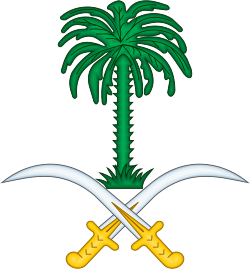Almezmar in Saudi Arabia
Almezmar or mizmar (Arabic: مزمار) is a traditional group performance and stick song-dance that is performed by the population inhabiting Alhijaz region in western Saudi Arabia for festive occasions such as wedding and national events. Almezmar is performed by about 15–100 practitioners who twirl long sticks (bamboo cane), beat drums and clap to songs that can pertain to a variety of topics such as heroism, praise, chivalry, love and generosity. In the past, the ritual was associated with battle or competition. It closely resembles the tahtib dance practiced in Egypt and Sudan.[1]
| Almezmar | |
|---|---|
| Country | Saudi Arabia |
| Domains | drumming and dancing with sticks |
| Reference | 01011 |
| Inscription history | |
| Inscription | 2016 |
| List | Representative |
 | |
'Mizmar' is actually the generic term for most any wind instrument found in the Hijaz or Asir, from the end-blown flute to the dual-piped boos. But the name of the art mizmar is confusing because the mizmar song-dance does not call for any wind instrument—there is no mizmar in mizmar, just drums."[1]
In 2016, Almezmar was inscribed on the UNESCO's Representative List of the Intangible Cultural Heritage of Humanity, considered as cultural expression representing the community identity.
Performance
Performing Almezmar (mizmar) involves a group of men standing in two facing lines or in a large circle holding a stick, and when the drums start beating, the leader of each line begins to clap and chant loudly rhythmic songs called "zumaal" or "mizmar." The first row of men repeats the song with a strong clapping, and then the second line sings antiphonally.
See also
References
- "Mizmar" in Lisa Urkevich, Music and Traditions of the Arabian Peninsula: Saudi Arabia, Kuwait, Bahrain, and Qatar. New York: Routledge, 2015. pp 193–196.
